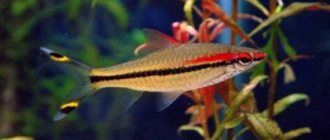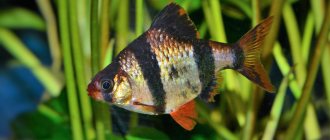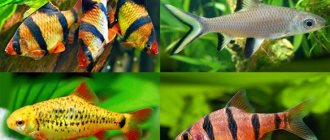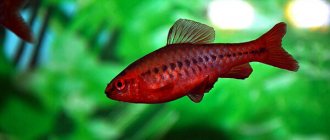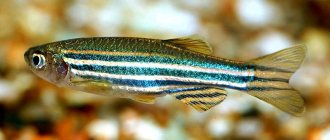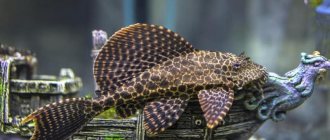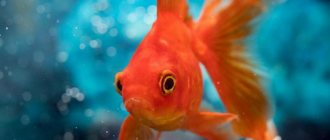5
(4)
Active fish are always interesting. Many aquarists, when they think about what kind of pets they want to see in their artificial pond, imagine just such animals. Not surprising, because mobile representatives of the underwater fauna will not get bored. Moreover, they often have bright colors and unusual habits, which makes them popular with both professionals and beginners. The mossy barb is one of these fish.
Description
The species lives in the central and southern parts of the Sumatra islands, on the Malay Peninsula, and also in Thailand. Some wild populations of the barb are found in the waters of the United States, Colombia, Suriname and Australia.
— Advertising —
Its habitat is densely planted rivers with clean water. The species prefers quiet forest streams and tributaries with oxygenated water. The substrate typically consists of sand and rocks with dense vegetation. In the wild, the mossy barb feeds on insects, diatoms, invertebrates and detritus (organic remains).
Why is it called that?
Their species name tetrazona refers to the four-stripe pattern, which distinguishes it from barbs with 5 or 6 stripes.
General characteristics
The body of individuals is tall and short, flattened laterally. The main color of the body is golden-pink, the back is darker and comes with a hint of red. The abdomen is yellowish-white and the front of the head is brownish-red.
— Advertising —
On the lateral sides of the body there are four black vertical stripes: the first runs along the eye, the second behind the pectoral fin, the third behind the dorsal surface (dorsal is the surface or side of the animal’s body, which is directed upward), and the last near the tail.
The bottom of the dorsal fin is black and the top is red. The pectoral fins are red, the rest are transparent or have a pinkish tint. Scientists have bred several selective species of mossy barbs.
The most common is the green barb, the stripes of which are combined into one solid one, and the body is dark green. The albino barb has a light pink body, white stripes and red eyes. The size of the species in the wild is 7-10 cm; in an aquarium, the body length does not exceed 5 cm.
The lifespan of the mutant barbus fish is about 3-4 years (in captivity).
Reproduction
The only difficulty in breeding mossy barbs is their tendency to cannibalism. Careless parents are not averse to eating their own caviar and fry. Therefore, for reproduction, a spawning tank with a net at the bottom or dense thickets of ground cover plants is required.
A pair is selected from the brightest, well-colored fish.
They begin to be fed with live protein food to stimulate the maturation of eggs and their proper formation. Individuals ready for spawning can be easily identified by the rounded abdomen of the female and the red head of the male.
A couple are placed in the spawning tank in the evening so that in the morning the fish are ready to reproduce. The female lays 200 small yellowish eggs, which the male fertilizes. After spawning is completed, the parents must be removed from the spawning tank. They do not care about their offspring and can destroy the clutch.
Experienced aquarists advise adding a solution of methylene blue to the water. After 34-36 hours, the eggs will hatch into larvae. The nutrients in their yolk sacs are enough for 5 days. After the granules are absorbed, the fry actively begin to search for food.
The fry feed on “live dust”, microworms, and ciliates. After a while, the fish can be switched to larger food or ready-made food for barb fry. After a month, the fish acquire a characteristic color.
The mossy barb will become a decoration of the aquarium, provided that the parameters of the aquatic environment and feeding rules are observed. This beautiful fish is suitable even for beginner aquarists.
Content
The mossy barb fish is easy to keep and care for, so it is suitable for aquarists with any experience. It is hardy as long as the water is kept clean and changed regularly. Mutant barbs are active and playful individuals that swim quickly. They will eat any type of food you offer them. Their reproduction occurs just as easily.
Requirements for an aquarium
- Mutant mossy barbs swim in all parts of the aquarium, but prefer open areas in the middle. Since their size is up to 5 centimeters, a school of fish will need at least a 55-liter aquarium. However, these are active swimmers, so they will feel much better in an aquarium 75 centimeters long and 100 liters in volume.
- Provide filtration and change the water regularly.
- Keep the aquarium covered as these fish may jump.
- The bottom of the aquarium should be covered with fine gravel with large stones or cobblestones, which the individuals will use as shelter.
- Lighting: moderate.
- Plant vegetation on the sides and corners of the aquarium, leaving the center open for free floating. Thailand fern and Hygrophila varifolia are good choices as they do not require special lighting and are compatible with both mutants and their tankmates.
Water requirement
- Water temperature: 25-27.8°C. For green species, at least 25°C.
- Water hardness is not a key parameter, but it is still better that it does not exceed 16 dH.
- pH of the environment: 6.5-8.0.
Change the water in the aquarium at least once a week (up to 25% of the tank capacity). In old water, the amount of nitrogen increases, which leads to diseases of individuals.
What to feed?
Barbus is a mutant omnivorous fish. It can be fed with any live, plant or dry food. A high-calorie diet leads to obesity, as a result the male loses the ability to fertilize, and the female is unable to lay eggs and dies. The presence of plant foods in the species’ diet reduces the risk of obesity and also prevents adults from nibbling on aquarium plants. Additionally, feed the species live food at least once a week; otherwise, they will attack and nip the fins of less active tankmates.
The general rule when feeding multiple times a day is to offer only as much as they can eat in 3 minutes. When offering food only once a day, estimate how much they will eat in 5 minutes.
Nutrition
Mossy barbs are unpretentious in food and do not complain of appetite. They can be fed live, frozen protein food:
- bloodworm;
- tubifex;
- Artemia;
- coretra.
High quality dry food with herbal supplements and vitamins to enhance color is suitable for feeding. A balanced diet should contain plant food - pieces of lettuce, cabbage, and dandelion scalded with boiling water.
Finely chopped young zucchini and pumpkin will appeal to the inhabitants of your home pond.
Compatibility with other fish
Compatible
The mutant barb is an active schooling fish that must be kept in a group of at least 6 individuals. If her flock is less than 6 members, she begins to pinch the fins of other inhabitants of the aquarium. You can place barbs with active fish of the same size, such as zebrafish, thorns and congo tetras.
Not compatible
You should not keep your eye on a slow fish that has long fins. Bad tank mates: freshwater angelfish, betta fish, goldfish, dwarf gourami.
Preparation of parents and spawner
Sexually mature barbs are placed in a feeding aquarium, the capacity of which is determined at the rate of 5 liters/one individual. Before the barbs begin to reproduce, the fish are placed in tanks depending on their gender, where they are kept for two weeks. During this time, the eggs of female fish will mature. If the barbs are kept for more than three weeks, the pets will die without completing reproduction.
In order for the pets to spawn successfully, the parents are intensively fed with vitamins.
The spawning container where the fish reproduce is selected to be low - up to 30 cm, with a wide bottom. A net is laid out in the spawning tank so that the parents do not eat the eggs, and Java moss. The beginning of spawning is stimulated by fresh, oxygenated liquid with a temperature of 25-28C.
Breeding
The mossy barb reproduces moderately easily. Raising fry is also not a difficult task. This species chooses a partner for itself at a time. To start breeding, you need to select a male and female from the flock. For spawning, choose a female with a bulge on the front of the abdomen and the brightest male representative.
Individuals become sexually mature at the age of 5-9 months.
Requirements for the spawning tank
- For one couple, use an aquarium with a capacity of at least 15 liters.
- Place a dividing net at the bottom of the tank (the eggs should pass through it easily).
- Plant a large number of small-leaved plants.
- The substrate doesn't matter, so you can do without it.
- Fill 50% of the spawning tank with water from the old aquarium, add 25% fresh sedimented water and 25% rain or distilled water (to reduce hardness). Hardness should be up to 10 dGH.
- Water temperature in the tank: 25-28°C.
- Ensure that the aquarium receives morning sunlight.
- pH slightly acidic: about 6.5.
Breeding procedure
- It is desirable that the man is slightly older than the female. Before spawning, feed the fish a nutritious protein diet for one to two weeks. Once a day is enough to avoid obesity.
- First, place the female in the prepared aquarium, and submerge the male after a couple of days, when she is full of eggs. The courtship ritual will begin in the late afternoon, when the individuals will swim around each other. The male will perform a "headstand" and spread his fins to arouse the female.
- Spawning of mutant barbs begins in the morning and lasts 2-3 hours. A female will release 1 to 3 eggs at a time. A total of up to 300 eggs will be laid, although more mature females may lay 700 or more. Next, the male will fertilize them.
- After fertilization, the parents must be removed as they will eat the eggs. The eggs will hatch in 48 hours and the fry will begin swimming freely after 5 days.
- Feed them ciliates, rotifers, small shrimp, etc. A week after the babies start swimming, you can give them some other small food. Be careful when feeding as uneaten food can quickly contaminate the water and the fry need clean water to survive.
- When green barbs are bred, 75% of their fry will be of this species, and 25% will be normally colored. If one of the fish in a pair has a normal color, then 25-40% of their babies will be green.
Matching
When choosing a pair of future parents, owners pay attention to the following details:
- Purity of color.
- Exterior quality.
- Females have a rounded belly.
- Energetic behavior of males.
To breed barbs, purebred fish are used; as a result of spawning, about 75% of mutants and 25% of albinos are obtained. Mutants reach sexual maturity at 9-12 months, with males maturing 1.5 months later than females.
It is possible to distinguish fish by gender only after the mating season. Differences between a female and a male:
- In boys, the color is richer and more intense.
- Girls are larger and more plump, with a rounded tummy.
- Males have a scarlet mark on their muzzle.
Diseases
Basically, these aquarium fish do not get sick. But in the process you may encounter the following problems:
- Obesity. It manifests itself as bloating and apathy of the individual. You should reconsider your diet and diet.
- Rubella. It manifests itself as abdominal dropsy, as well as protruding fish eyes and white crusts on the body. The disease is transmitted from other animals or caused by dirty aquarium water. For treatment, you can use antibiotics (for example, chloramphenicol), but it is better to consult a specialist.
- White-skinned. It manifests itself as a decrease in the brightness of the color near the dorsal and caudal fins. The mossy barb fish swims poorly and looks sluggish. Place the individual in a separate container, after adding antibiotic water. You should also consult a specialist.
- Excess ammonia in water. It manifests itself as the fish's breath, red spots on the body. You need to change the aquarium water by 50%.
History of appearance
The first mossy barbs appeared in Germany in 1976 and began their triumphal march across Europe. They came to the USSR in 1977 from Czechoslovakia. Thanks to the efforts of breeders, today the mossy barb delights customers in pet stores with emerald schools of frisky fish. In addition to the green color mutation, there are gold, platinum, red Sumatran barbs and even albinos.
Interesting Facts
- The specimens were once called "Sumatran" as they are native to Sumatra. Other common names are Sumatra Barb, Partbelt Barb and Tirger.
- The mutant barb was first described in 1885.
- The species has a reputation for being aggressive and dominant. Although they are very assertive and love to hit and bite their tank mates, their behavior is more annoying than harmful.
- It is almost impossible to produce albino adults because if one of the fish in a pair is albino, about a quarter of their offspring will inherit this coloration. Albino fry of the mutant barb are whimsical in their content. They are sensitive to water parameters and picky about food in the aquarium. If aquarists do not comply with favorable conditions, they die.
Useful tips
Growing barbs, despite its apparent simplicity, is fraught with many difficulties. All of them arise when the fish are kept improperly.
Advice from experienced aquarists:
- the best shape of an aquarium is an elongated parallelepiped;
- if the barbs are hanging upside down, it means they do not have enough oxygen, you need to lower the temperature by a couple of degrees and increase aeration;
- Young barbs grow very quickly, so you need to vigilantly monitor their growth, planting them in a larger container in time.
Mating games
One boy and one girl are chosen for spawning. If the female actively attacks the male, then he should be replaced.
06:05
Mating games of barbs, or the eggs have been brought in!
To protect the female from overly aggressive or active males, algae is placed in the aquarium. A fish can hide from an annoying admirer among the foliage.
After the female has laid all her eggs, the fish immediately lose interest in each other. After some time, they begin to look for eggs and eat them. After such a signal, the barbs are immediately returned to the general aquarium.
The signal about the end of spawning is often the behavior of the female. She avoids communication with the male
Eggs that do not contain an embryo are visible 12 hours after spawning. it turns white and becomes cloudy. It can be removed using a pipette.
Feeding
Mutant is omnivorous and eats dry, fresh and frozen food well. Given your pet’s passion for clean water, it is recommended to purchase premium products that do not pollute the aquarium as much. Barbus's balanced diet should look like this:
- Tubifex, bloodworms and other live food - 6/10.
- Spinach, dandelion flowers, salad - 3/10.
- Compound feed specialized for this species - 1/10.
Fish eat a lot and uncontrollably, so as not to harm their pets, each dose is calculated. It is not recommended to give the daily dose at a time; it is better to give it a little in the morning and evening. This diet will save you from obesity.
Sex differences
It is quite difficult to distinguish a male from a female. Before the breeding season, the mossy barb has virtually no visual sexual differences. During spawning they appear: the female has a more rounded and thick belly, and the male is more intensely colored. In addition, the overwhelming majority of males are slightly smaller than females.
When buying fish at a pet store, it is impossible to distinguish a female mutant barb from a male, and therefore you can only hope that you will get fish of both sexes, if, of course, you plan to breed them.
